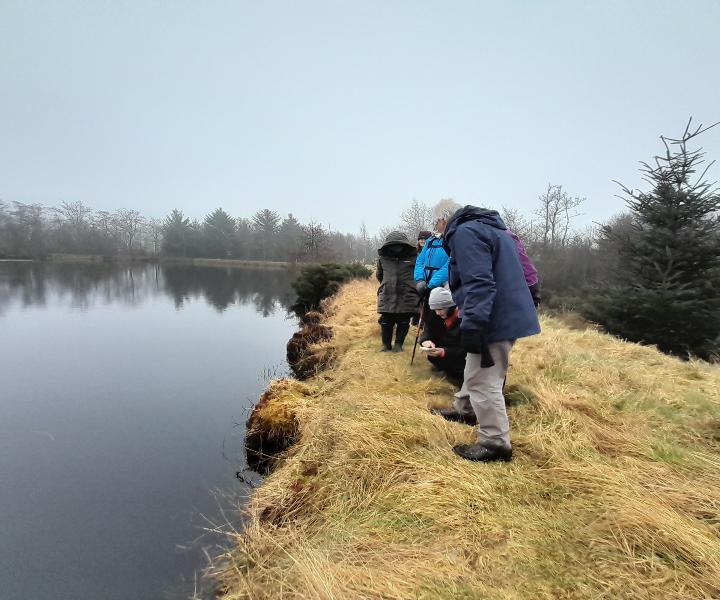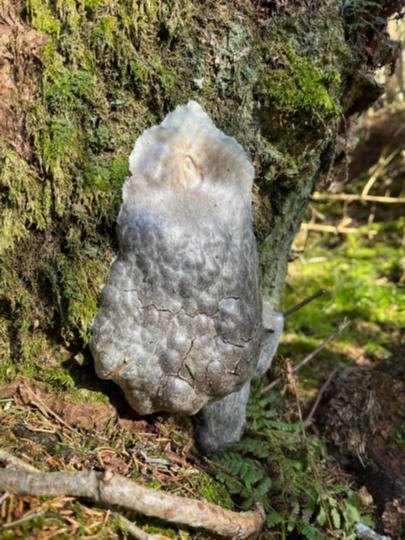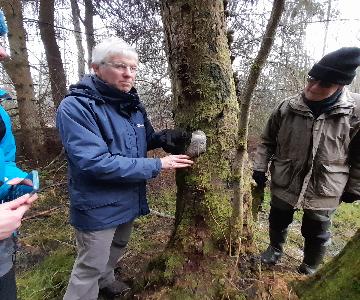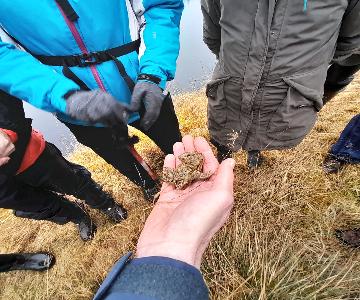Wildlife Group - Mammal Tracking Event
April 2025
Wildlife Group visit loch – mammal signs.
On Saturday 22nd March 8 of us met at the loch to look for signs of otters and other mammals.
The loch is used by large numbers of breeding frogs and toads, and this attracts a lot of otter activity on a feeding bonanza. For some reason amphibian activity was much less than we have seen in previous years, so evidence of feeding otters was harder to find. We did see a number of toads in and around the loch, so they were definitely about.
Nevertheless, we found several tracks through bank vegetation where otters gained access to and from the loch. Beside some of these, were marooned heaps of unexpanded frog spawn. These are likely to have been expelled by pregnant females when caught and eaten by an otter using the access.
We also found a few heaps of formless dark otter spraint on grass tussocks. These were left by a female otter and her cubs to tell other otters that they were present. These contained many fragments of frog and toad bones.
A curved, cylindrical dropping about 2cm long was located on the concrete support of a small bridge over the loch outlet. This will have been deposited by a female, possible without cubs, to mark her territorial presence. This was much pinker in colour and again contained amphibian bones and some fish scales.
This sort of obvious landscape feature is often a good place to find otter spraint marking a territory by water. Boulders at the confluence of a tributary are also favoured. If you find a much smaller smear of a dark fishy smelling dropping, this would be the spraint of a male otter. Their spraints are much smaller than those of females because they must eke them out to mark more features in a much larger territory. They are therefore more economical with their pooping!
In addition to otter signs, we found a pine marten dropping on an upturned rowing boat and on a small rock in a track. The droppings are long and narrow and nearly always curved. Their size and colour can vary according to what they have eaten. One of these droppings contained some undigested sunflower seeds, while the other was full of partially digested rowan berries.
The grey tapered droppings of fox were also found. These contained a high proportion of fur.
After looking around the loch, we went to see a badger sett on a steep bank nearby. The badger sett had several openings, as is usual for the species. This provides security for an extended family and helps with air flow-through for ventilation. Outside each hole was a large mound of excavated material, which is another common feature of badger setts.
Nearby were some shallow pits excavated by the badgers as latrines. These contained large, amorphous droppings, owing to a large part of a badger’s diet consisting of worms.
As a diversion, and to show we weren't totally obsessed with mammal droppings, we went to see a very unusual looking organism on a dead alder tree. This was a slime mould. This species is acellular, which means that its original colony of mobile individual cells had merged into one large multi-nucleate mass. The outer layer of the mass was wonderfully silvery white, and it was in the process of producing billions of brown spores for dispersal. None of us had ever seen anything like it before, but it occurs throughout Britain and Europe, and also in Mexico. Its English name is false puffball, but when translated, its Mexican name is more graphic – moon poo! If you are interested, look it up on the internet. Slime moulds are like no other living organism on earth, and this was a great find.
Report written by David Bale - Bailies of Bennachie Environment Trustee



